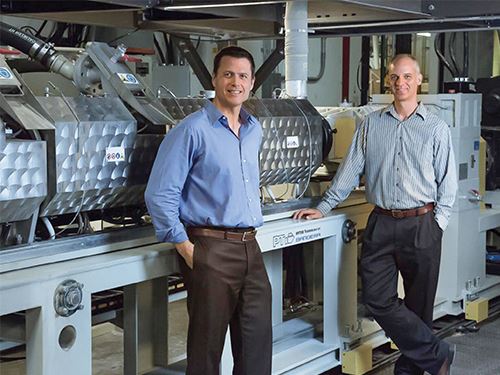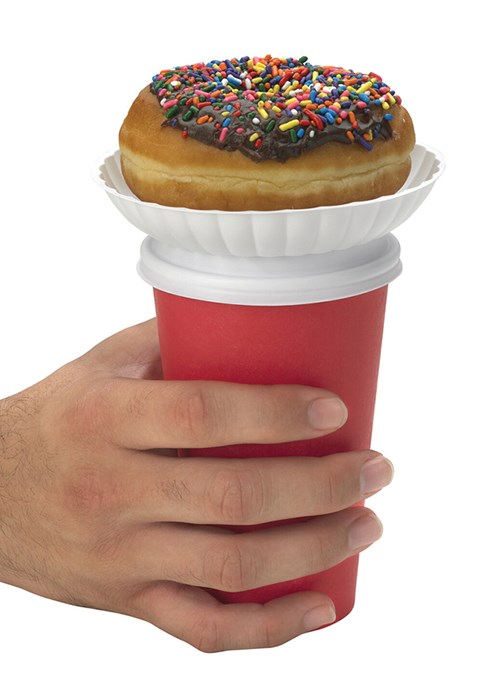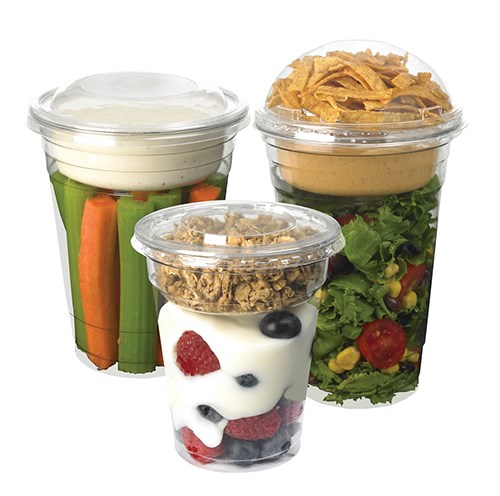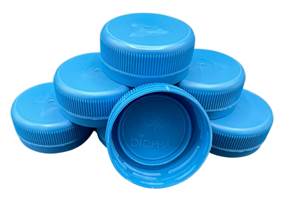There’s No Lid on This Processor’s Creativity
On Site: LidWorks
For this lid maker, the keys to success are speed, flexibility and ingenuity.
How does a sheet processor and thermoformer compete in a packaging market dominated by behemoths? For M&N Plastics Inc., a supplier of lids for hot and cold beverages, the keys are speed, flexibility, and outside-the-box creativity.
“What we do each and every day is shift from one product to the next, pull tooling out, and start up again, very quickly” states Ugo Mazzarolo, v.p. and general manager of the company, which does business as LidWorks. “We don’t have dedicated lines. In fact we can run three or four different items on the same line, at the same time, for different customers.”
LidWorks is a privately held company that was resurrected from bankruptcy in 1985 by Mazzarolo’s father, who previously ran a company called Heat Seal Packaging, which made aluminum foil lids. At the time, LidWorks’ predecessor company was forming lids using typical flat-bed thermoforming technology. By the time Ugo joined the company in 1999, his dad had already developed a proprietary thermoforming technique that allows for quick changes and multi-product runs while minimizing up-front tooling expenses for the customer. With this home-built technology, customers only have to pay for cavity inserts, rather than an entire mold.
“The techniques we have developed for forming lids are different from commercially available flat-bed thermoforming systems,” states Mazzarolo. “It’s a continuous system that allows us to take advantage of a modular platform requiring the customer to invest only in the forming inserts. It also speeds things up for us because we can run multiple products on a single tool simply by switching out the inserts.”
Mazzarolo adds, “The key for us is to get in and out of setups quickly, and the way we manage our form and trim tooling makes that possible. On a typical line making cold lids, for instance, we might be running three or four different SKUs that we are able to move quickly in and out. That advantage would not be possible without our tooling technology.”
Today LidWorks operates out of a 110,000 ft² facility in Plant City, Fla., employing between 140 and 200 people, depending on demand—summer months tend to be the busiest for lid makers because of increased consumption of cold beverages. The company runs 24/7 during the summer, 24/5 otherwise. It has 16 extrusion systems that run in-line with its home-made thermoformers. Five of these 16 lines are what Mazzarolo describes as “high-capacity.”
The company can produce up to 5 billion lids a year. In extrusion capacity terms, that translates to about 25 million lb/yr. Until recently, most of that was polystyrene. Sheet thickness ranges from 9 to 18 mil, the thicker used mostly for domed lids. The end markets are various, and include fountain, frozen, hot, grab n’ go, recycled, and specialty. One line is set up for coextrusion to make lids for cappuccino. “There is a larger set of performance criteria for cappuccino lids because in this application the PS is subjected to specific environmental stresses,” Mazzarolo explains. “These stresses will lead to lid failure, and the end result of that is hot coffee in people’s laps.” LidWorks deals with this by producing a two-layer lid with an environmental stress-crack resistant grade of PS in the bottom layer, and a blend of other PS-based materials in the top layer.
This combination of material grades also gives more sheen to the lid, which consumers find aesthetically appealing. “One thing we always emphasize while presenting our capabilities to customers is that there is a far more intimate relationship between the consumer and lid than there is between the consumer and the cup,” Mazzarolo states. In the coming months, LidWorks will be converting one of its high-capacity lines to a second coextrusion setup.
LidWorks is the only North American lid producer that makes just lids. Its specialization is another key to its success. Says Mazzarolo, “I can’t think of a lid on the market for which we can’t provide a better solution.” Most of the others in the lid-making business, including giants such as Berry Plastics and Dart Containers, make lids to support their cup business. These and other such processors are both LidWorks’ competition and customers.
“We try to be as flexible as we can in the way we come to market,” Mazzarolo says. “When the cup guys need lids from us because of their capacity issues, we’ll take on the business. At the same time we know that business will drop off when their demand levels off, so we’ve positioned ourselves to handle specialty promotional business and also business from quick-serve restaurants (QSRs) and convenience stores. This end-user business is where we see big opportunities for growth. Some QSR chains are actually part of common ownership groups, so if we get our brand exposed in one restaurant that could possibly lead to business opportunities in another, related QSR.”
NEW PET LINE
While LidWorks develops a lot of technology in-house, it is not gun-shy about investing in commercially available technology. A $7.5 million expansion in 2007-2008 allowed it to double its lid capacity. More recently, it expanded beyond PS lids with its first line for PET sheet. Rather than go the conventional route with single-screw extrusion teamed with dryers and crystallizers, LidWorks opted for the High-Vacuum Twin-Screw Extruder (HVTSE) system furnished by Processing Technologies International, Aurora, Ill., in cooperation with Luigi Bandera, an Italian builder of twin-screw machines.
The HVTSE system requires no drying. The extruder features three vents: one is atmospheric and the other two use high vacuum to pull moisture and volatiles from the material. “There is certainly a trend in clear lids moving from PS to PET, and when we made the decision to expand into PET we wanted to do so with cutting-edge technology,” states Mazzarolo. “The new line can also run materials such as PP and PLA without the need to make any screw changes, and that level of flexibility was also important to us.”
Adds Bob Schaefer, LidWorks’ technical manager, who has a background in PET from his years in the cup business, “PTi made us comfortable from the start by pointing out things upfront. For example, this was not only our first experience with PET, but our first with twin-screw technology and our first with loss-in-weight feeding. It was a completely new dynamic for us to have line output dependent solely on the feeding system.”
The new line features an 85-mm extruder with a 52:1 L/D ratio, a screen changer and melt-pump package from Kreyenborg Industries, Lawrenceville, Ga., and a single-layer die from Nordson EDI, Chippewa Falls, Wis. The five-component gravimetric system comes from Doteco, Dayton, Ohio.
The line also features a real-time intrinsic viscosity indicator; Schaefer reports that IV can kept at acceptable levels even with high use of process regrind. The line typically runs at up to 2200 lb/hr. When taking into account upgrades needed in electrical, chilling, and compressed-air capacity, the total investment in the new sheet and thermoforming line was about $4 million.
For PET, LidWorks extrudes rolls and thermoforms off-line, using a CS-5500 former and a T-350L trim press, both furnished by Brown Machine, Beaverton, Mich. (brown-machine.com). The line produces lids at a rate of 110,000/hr. Trim scrap is granulated and conveyed back to the extruder in a closed loop. At present, LidWorks has sufficient PET extrusion capacity for a second thermoforming line, which Mazzarolo plans to add in the upcoming months.
CREATIVE PRINTING
LidWorks’ outside-the-box thinking does not stop at extrusion and forming. The firm also developed and patented a process allowing lids to be printed inline. “Of course there are numerous ways to print on lids, but those are all secondary operations,” says Mazzarolo. “Ours is inline, and we are constantly making modifications to it and updating the patents. In fact, the technology now is in its third generation, and we have not only designed the process but built the equipment to make it possible.”
For printing, LidWorks has a minimum order quantity of 1 million lids. It can offer two-color and flat printing, as well as embossed printing. It has capacity to print 10 million lids/week. LidWorks also has deployed a rather unique conveying system. In a setup that looks somewhat like an airline’s baggage-handling conveyor, cartons full of lids are automatically taped, bar coded, and sent to one of a handful of palletizing lines before being loaded on trucks.
Each lid is also supported by R&D and prototyping services that LidWorks guarantees will meet customer preference and offer optimum results. Tolerance tests are performed to ensure that the product meets the highest performance standards. As part of its quality-control process, LidWorks routinely performs lid and cup geometry analyses to ensure microscopic precision and fit between lid and cup.
Related Content
For Extrusion and Injection-Blow Molders, Numerous Upgrades in Machines and Services
Uniloy is revising its machinery lines across the board and strengthening after-sales services in tooling maintenance, spare parts and tech service.
Read MoreMultilayer Solutions to Challenges in Blow Molding with PCR
For extrusion blow molders, challenges of price and availability of postconsumer recycled resins can be addressed with a variety of multilayer technologies, which also offer solutions to issues with color, processability, mechanical properties and chemical migration in PCR materials.
Read MoreImpacts of Auto’s Switch to Sustainability
Of all the trends you can see at NPE2024, this one is BIG. Not only is the auto industry transitioning to electrification but there are concerted efforts to modify the materials used, especially polymers, for interior applications.
Read MorePHA Compound Molded into “World’s First” Biodegradable Bottle Closures
Beyond Plastic and partners have created a certified biodegradable PHA compound that can be injection molded into 38-mm closures in a sub 6-second cycle from a multicavity hot runner tool.
Read MoreRead Next
Making the Circular Economy a Reality
Driven by brand owner demands and new worldwide legislation, the entire supply chain is working toward the shift to circularity, with some evidence the circular economy has already begun.
Read MoreSee Recyclers Close the Loop on Trade Show Production Scrap at NPE2024
A collaboration between show organizer PLASTICS, recycler CPR and size reduction experts WEIMA and Conair recovered and recycled all production scrap at NPE2024.
Read More
























